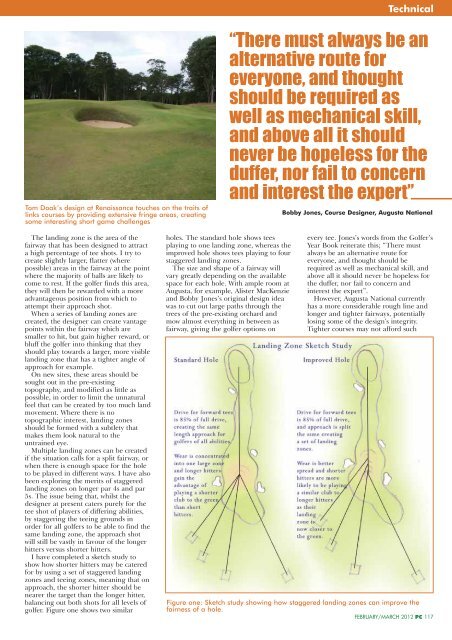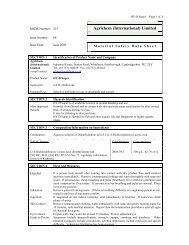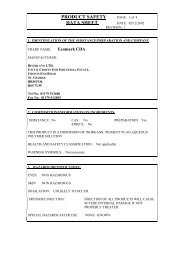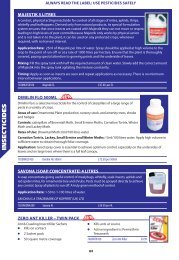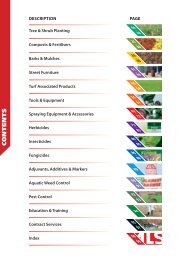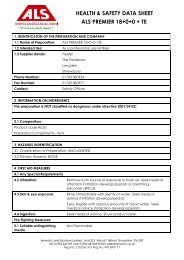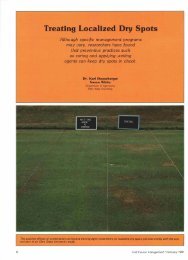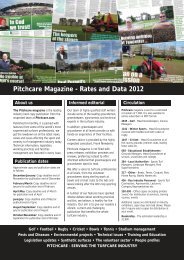these Open Championship Clubs choose to relief grind - Pitchcare
these Open Championship Clubs choose to relief grind - Pitchcare
these Open Championship Clubs choose to relief grind - Pitchcare
You also want an ePaper? Increase the reach of your titles
YUMPU automatically turns print PDFs into web optimized ePapers that Google loves.
Tom Doak’s design at Renaissance <strong>to</strong>uches on the traits of<br />
links courses by providing extensive fringe areas, creating<br />
some interesting short game challenges<br />
The landing zone is the area of the<br />
fairway that has been designed <strong>to</strong> attract<br />
a high percentage of tee shots. I try <strong>to</strong><br />
create slightly larger, flatter (where<br />
possible) areas in the fairway at the point<br />
where the majority of balls are likely <strong>to</strong><br />
come <strong>to</strong> rest. If the golfer finds this area,<br />
they will then be rewarded with a more<br />
advantageous position from which <strong>to</strong><br />
attempt their approach shot.<br />
When a series of landing zones are<br />
created, the designer can create vantage<br />
points within the fairway which are<br />
smaller <strong>to</strong> hit, but gain higher reward, or<br />
bluff the golfer in<strong>to</strong> thinking that they<br />
should play <strong>to</strong>wards a larger, more visible<br />
landing zone that has a tighter angle of<br />
approach for example.<br />
On new sites, <strong>these</strong> areas should be<br />
sought out in the pre-existing<br />
<strong>to</strong>pography, and modified as little as<br />
possible, in order <strong>to</strong> limit the unnatural<br />
feel that can be created by <strong>to</strong>o much land<br />
movement. Where there is no<br />
<strong>to</strong>pographic interest, landing zones<br />
should be formed with a subtlety that<br />
makes them look natural <strong>to</strong> the<br />
untrained eye.<br />
Multiple landing zones can be created<br />
if the situation calls for a split fairway, or<br />
when there is enough space for the hole<br />
<strong>to</strong> be played in different ways. I have also<br />
been exploring the merits of staggered<br />
landing zones on longer par 4s and par<br />
5s. The issue being that, whilst the<br />
designer at present caters purely for the<br />
tee shot of players of differing abilities,<br />
by staggering the teeing grounds in<br />
order for all golfers <strong>to</strong> be able <strong>to</strong> find the<br />
same landing zone, the approach shot<br />
will still be vastly in favour of the longer<br />
hitters versus shorter hitters.<br />
I have completed a sketch study <strong>to</strong><br />
show how shorter hitters may be catered<br />
for by using a set of staggered landing<br />
zones and teeing zones, meaning that on<br />
approach, the shorter hitter should be<br />
nearer the target than the longer hitter,<br />
balancing out both shots for all levels of<br />
golfer. Figure one shows two similar<br />
holes. The standard hole shows tees<br />
playing <strong>to</strong> one landing zone, whereas the<br />
improved hole shows tees playing <strong>to</strong> four<br />
staggered landing zones.<br />
The size and shape of a fairway will<br />
vary greatly depending on the available<br />
space for each hole. With ample room at<br />
Augusta, for example, Alister MacKenzie<br />
and Bobby Jones’s original design idea<br />
was <strong>to</strong> cut out large paths through the<br />
trees of the pre-existing orchard and<br />
mow almost everything in between as<br />
fairway, giving the golfer options on<br />
Technical<br />
“There must always be an<br />
alternative route for<br />
everyone, and thought<br />
should be required as<br />
well as mechanical skill,<br />
and above all it should<br />
never be hopeless for the<br />
duffer, nor fail <strong>to</strong> concern<br />
and interest the expert”<br />
Bobby Jones, Course Designer, Augusta National<br />
every tee. Jones’s words from the Golfer’s<br />
Year Book reiterate this; “There must<br />
always be an alternative route for<br />
everyone, and thought should be<br />
required as well as mechanical skill, and<br />
above all it should never be hopeless for<br />
the duffer, nor fail <strong>to</strong> concern and<br />
interest the expert”.<br />
However, Augusta National currently<br />
has a more considerable rough line and<br />
longer and tighter fairways, potentially<br />
losing some of the design’s integrity.<br />
Tighter courses may not afford such<br />
Figure one: Sketch study showing how staggered landing zones can improve the<br />
fairness of a hole.<br />
FEBRUARY/MARCH 2012 PC 117


